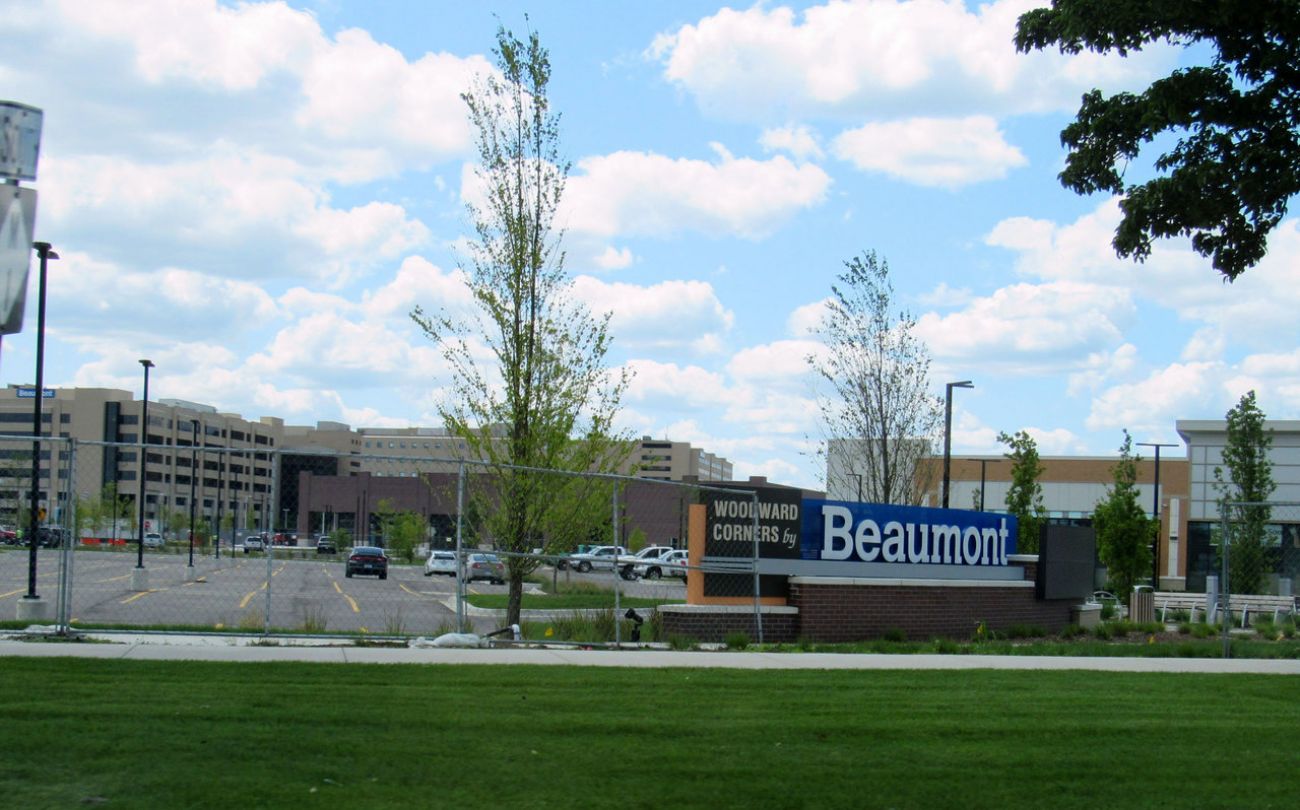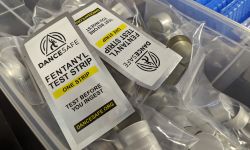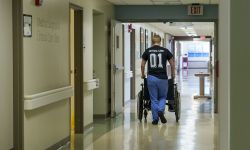Michigan hospitals hardest hit by coronavirus get $850M, say they need more

Seven large Michigan health systems hit hard by the coronavirus outbreak have received more than $850 million in federal funds, according to federal data. The funds are meant to patch budget holes suffered by providers in “high-impact” areas.
But hospitals — some of which have laid off thousands of workers in recent months — maintain the money falls far short of what’s needed to make up for losses. Some, in fact, continued this week to cut staff.
“The federal stimulus money … does not fully cover all losses,” said Laura Blodgett, a spokeswoman for Trinity Health Michigan, part of Livonia-based Trinity Health.
Though 1,200 of Trinity’s 2,600 workers laid off in the spring returned to work, furloughs have been extended for others and other employees that represent “full-time equivalents” face layoffs or reduced hours, Blodgett said.
Trinity and others say the federal funds fall short of the millions lost as hospitals shut down higher-revenue non-emergency procedures so they could focus attention on a crush of COVID-19 patients in March, April and May.
It’s an “irony for health care that's different than other businesses,” said Bob Riney, chief operating officer at Henry Ford Health System, which treated hundreds of COVID-19 patients a day at the height of the pandemic.
Henry Ford has received $182.4 million in “high-impact” funds for its work with COVID-19 patients, federal data show.
During the pandemic, Riney said, “you're the heroes in the community. You're doing everything you can beyond any means…., putting yourself at risk to make sure that community is safe. But you're also having to furlough employees because you have to shut down other big parts of your operation,” he said.
“I can understand why people would be confused — even internally. You're paying premium pay and surge pay and doing everything you can to get your people in hospitals to work 16-hour days, and you're telling someone else, ‘You're going to have to go on furlough because there’s not work for you,’” he said.
As of last Friday, Henry Ford had cared for 3,947 patients hospitalized with COVID-19 since the outbreak first hit Michigan. The extraordinary costs of pandemic care — special equipment, personal protective gear, additional staff — exceeded $80 million, said Robin Damschroder, the system’s executive vice president and chief financial officer.
Stories from the front
Bridge Magazine, Detroit Free Press and Michigan Radio are teaming up to report on Michigan hospitals during the coronavirus pandemic. We will be sharing accounts of the challenges doctors, nurses and other hospital personnel face as they work to treat patients and save lives. If you work in a Michigan hospital, we would love to hear from you. You can contact reporters Robin Erb rerb@bridgemi.com at Bridge, Kristen Jordan Shamus kshamus@freepress.com at the Free Press and Kate Wells katwells@umich.edu at Michigan Radio.
But she and others said the greatest budget toll was in canceled procedures and a continued hesitancy of patients to return for nonemergency care because they feared contracting the virus. By the end of June, Henry Ford will likely have lost $500 million due to COVID-19, she said.
It happened across the country, said Chas Roades, cofounder and CEO of Gist Healthcare, a Washington-based advisory firm that works with health systems.
“What happened is the leg of the stool that was funding the hospital operations, the leg of the stool that pays for most of the profitability, got yanked out in those weeks,” he said.
Roades estimates that federal funding will backfill 40 to 50 percent of losses for the nation’s hospitals. Hospitals will continue to make cuts, and that may include staff, as they also struggle to return to pre-COVID patient loads, he said.
“Almost every health system I talk to will have a loss at the end of this year,” he said.
In April, Henry Ford announced it would furlough 2,800 employees. It was one of several hospital systems — Beaumont and Detroit Medical Center among them — announcing similar cutbacks.
“We can't stay in a negative position… You have to be prepared because you don't know what's going to happen. It's our job to preserve the health system for the long term,” Damschroeder said Friday.
Like Henry Ford, Beaumont Health treated hundreds of coronavirus patients a day at the height of the Michigan pandemic, and received $228.4 million in high-impact funds, the most of any Michigan health system, according to federal data.
Beaumont officials wouldn’t confirm federal funding totals or budget losses. John Kerndl, Beaumont Health Chief Financial Officer, said in an email that Beaumont officials “don’t know what our final grant funding will be,” and that the health system only releases financial information on a quarterly basis.
“Beaumont cared for more COVID-19 patients than any other health system in the state,” spokesperson Mark Geary said in an email. “The grant money will only partially offset those losses. We are using the money to help keep our business moving forward and fund our operations, including payroll, while we continue to take steps to recover from the pandemic,”
Beaumont has brought back 1,000 of the 2,475 employees it announced were being laid off in April, Geary said in the email.
During that April announcement, the system also said it would permanently cut about 450 positions, while its CEO, John Fox, vowed to take a 70 percent cut to his base salary and forego bonuses. According to IRS filings, Fox’s base salary in 2017 was $1.77 million, his bonus was $2.1 million, and retirement and other deferred compensation totalled $1.73 million.
Michigan Medicine, the academic medical center at the University of Michigan, announced a plan May 5 to reduce staff by 1,400 people. As it turned out, attrition and furloughs mean the system now will reduce its force by 738 employees instead, spokesperson Mary Masson said Tuesday.
Before COVID-19, Michigan Medicine projected a “positive operating margin of $175 million in fiscal year 2020.” But since the pandemic hit — even with an injection of $136 million in total federal funds, including $45.5 million in high-impact funds — the health system now predicts a $3 million operating loss.
The $850 million sent Michigan’s way is but one stream of federal money earmarked for health providers during the coronavirus.
The Provider Relief Fund, as it is known, includes money from two COVID-19 emergency measures passed by Congress and approved by the White House: the Coronavirus Aid, Relief, and Economic Security (or CARES) Act, and the Paycheck Protection Program and Health Care Enhancement Act.
The funds are meant to help a variety of providers. Those in the high-impact category split $12 billion in funds, disbursed to 395 U.S. hospitals that admitted 100 or more coronavirus patients by April 10.
In mid-March, as coronavirus bore down on the United States, many Michigan health providers canceled nonessential surgeries and procedures. The cancellations helped free up patient rooms and resources to handle the outbreak and kept others from possible exposure to the highly contagious virus. Many hospitals canceled those procedures even before Gov. Gretchen Whitmer required them to do so by executive order March 20.
In the next months, hospital systems said budget gaps grew quickly as hospital rooms filled with acutely ill and dying COVID patients, while the vast majority of non-COVID cases and hospital visits all but ended.
John Karasinski, a spokesperson for the Michigan Health & Hospital Association, an industry group, told Bridge and the Detroit Free Press that funds from the $175 billion Provider Relief Fund were vital to keeping hospitals financially stable. To stay afloat, hospitals were forced to furlough employees and reduce executive pay, he said.
“Hospitals are incredibly expensive to operate, and a majority of patients have insurance through a government program that doesn’t cover the cost of the care they receive,” he said.
“When you add these and other factors together, hospitals make a very small profit at the end of the year. When COVID-19 arrived and most services and procedures had to stop, there was very little money coming in the door – but the hospitals had to keep things up and running.”
Ascension Michigan, part of St. Louis-based Ascension Health, received $187.8 million, according to an online database managed by the U.S. Department of Health and Human Services. But across Ascension, which includes hospitals in at least 20 states, losses neared $2 billion during COVID-19, according to an Ascension spokesperson.
Detroit Medical Center, considered a safety-net health system with a high portion of patients who are poor, uninsured or under-insured, would not say whether it received the $108.6 million cited in the federal database, nor would it answer questions about its budgetary losses during the pandemic, despite repeated requests.
This is consistent with DMC’s consistent refusal to make basic information public during the outbreak. DMC previously would not publicly release information on the number of COVID-19 cases recorded during the state’s initial coronavirus surge.
DMC spokesperson Jason Barczy instead issued a statement that said, in part: “We are grateful for the federal assistance we have received, which has helped offset some, but not all, of the impact of the pandemic.”
Other large systems listed as receiving high-impact funds were McLaren Health Care, which received $34.7 million, and Trinity Health Michigan, which received $65.7 million, according to federal data.
Hundreds of millions of additional federal dollars in “general distribution” coronavirus relief have been distributed to Michigan’s large and small providers, including small doctors offices — payments as tiny as $8 and based on calculations that include previous Medicare payments. Other funds were separately awarded to rural hospitals and those deemed safety-net hospitals.
In Flint, city-owned Hurley Medical Center cared for about 350 hospitalized COVID-19 patients. The costs of intensive care for coronavirus patients, compounded by lost revenue from canceled procedures and emergency room visits that dropped more than half from pre-COVID levels, forced the independent hospital to furlough or lay off more than 150 workers, said Cass Wisniewski, Hurley’s chief financial officer.
As an independent, Wisniewski the hospital had no parent company to turn to for financial help. Hurley received $26.9 million from the Provider Relief Fund, which included $18.5 million in high-impact funds.
Wisniewski said Hurley lost about $15 million through May and losses continue. Even now, the hospital is performing just half of its elective procedures and treating about 180 people a day through its emergency department (pre-COVID levels were about 280 patients, Wisniewski said.)
About half of the 150 staff have returned, but many are working reduced hours, he said.
The funds, Wisniewski said, “help us get to a break-even point.”
It’s not clear how much federal funding Michigan health systems have received during the pandemic, particularly larger systems. Beyond the “high-impact payments,” the HHS database does not detail which kind of relief funds were issued or for what reason; nor does it make clear what providers belong to which parent health system. And the names of some entities that received federal funds don’t obviously line up with hospital names commonly known to the public.
Philip Mattera, research director of Good Jobs First, analyzed the data for Covid Stimulus Watch, a non-profit government watchdog, which tracks government data.
Mattera, who worked through tax identification numbers to match providers with parent companies, told Bridge and the Free Press he found multiple problems in the way HHS listed funding levels for Michigan hospitals.
“This is a lot worse than I’ve ever seen — the lack of details, the lack of clarity. If you look at databases put out by HHS or other government agencies, usually it’s the opposite — there’s too much information,” he said. “Here, you feel they were reluctant to release (the data), and they’ve made it as opaque as possible.”
Damschroeder, the Henry Ford executive, said at least one line listed an old name for Henry Ford’s Allegiance Hospital: W.A. Foote — which was changed more than a decade ago. At Michigan Medicine, spokesperson Mary Masson noted that the high-impact funds it received listed for the system’s Von Voigtlander Women's Hospital, when in fact the funds were provided for the larger health system.
U.S. Sen. Gary Peters, a Michigan Democrat and ranking member of the Senate Homeland Security and Governmental Affairs Committee, issued a report Tuesday suggesting hospitals across the U.S. still haven’t received all the federal coronavirus relief money they’ve been promised.
About 41 percent of the $175 billion allocated by Congress to the Provider Relief Fund three months ago still hasn’t reached hospitals, Peters said.
The delay, he said, has “increased ... the number of people who are laid off or are on furloughs, and is digging a deeper hole in the financial picture for hospitals and other health providers across the country.”
In addition, the report suggested stark disparities in how federal COVID-19 aid was distributed to states. It found that Michigan, a national coronavirus hot spot in March and April, received $31,045 per patient. The national average payout per COVID-19 patient was $160,286.
All told, Michigan hospitals have received about $2.1 billion in high-impact funds and other stimulus dollars, according to the MHA’s Karasinski.
And yet, Karasinski said, if Michigan’s hospitals are going to survive the pandemic, they’ll likely need more.
“We're very thankful for what they've been able to provide and help with so far,” Karasinski said, “but we have a long ways to go in order to make sure that all our hospitals are financially secure.”
See what new members are saying about why they donated to Bridge Michigan:
- “In order for this information to be accurate and unbiased it must be underwritten by its readers, not by special interests.” - Larry S.
- “Not many other media sources report on the topics Bridge does.” - Susan B.
- “Your journalism is outstanding and rare these days.” - Mark S.
If you want to ensure the future of nonpartisan, nonprofit Michigan journalism, please become a member today. You, too, will be asked why you donated and maybe we'll feature your quote next time!








